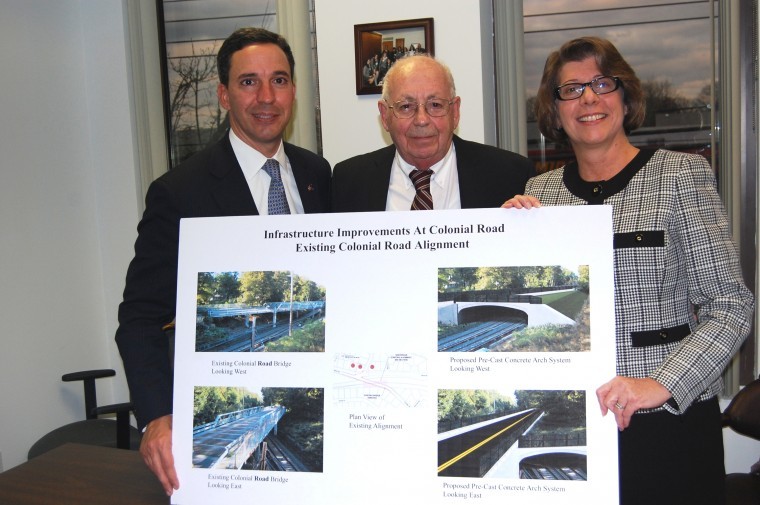For more than a decade, Village of Thomaston Mayor Robert Stern has been fighting to have the 100-year old Colonial Road Bridge replaced with the smallest possible impact to his community.
Last week, Stern’s effort finally paid off.
During a meeting at state Sen. Jack Martins’ (R-Mineola) office last Friday, Stern was able to come to an agreement with Long Island Rail Road President Helena Williams on a $36-million project, which will replace the bridge and add a pocket-track extension under a covered noise-reducing archway.
“Mayor Stern is a tenacious fighter for his community, as every mayor should be,” Martins said. “He really defended the local community and rightfully so. There were impacts to the community that need to be addressed.”
“Through his efforts and because he was so passionate about it,” he added of Stern, “literally the entire project was reevaluated … and they were able to come up with a rather creative solution to getting the bridge rebuilt in the same spot as the bridge that’s there now.”
The project to replace the Colonial Road Bridge is part of the Metropolitan Transit Authority East Side Access project, which will connect trains to Grand Central Terminal. The MTA operates the Long Island Rail Road.
Workers will replace the bridge, maintaining its existing alignment, while adding 325 feet of the proposed 1,500-foot pocket track extension under a pre-cast concrete arch system, which will support the roadway above. Additional work to add sound-absorbing materials to a retaining wall will also help control excessive noise generated from the pocket track.
“The village is very grateful for the considerable effort that Senator Martins did on our behalf,” Stern said. “We are very grateful for his efforts with the MTA, without which we would have had a different conclusion.”
The construction project is expected to begin sometime in 2013.
“I’m just delighted with the bridge,” Stern said. “The village is happy.”
The agreements caps off an often acrimonious negotiation between Thomaston and the LIRR.
After a number of months of talks, the LIRR announced in 2010 a plan that drew opposition from residents and Stern based on noise connected to the pocket-track extension. Stern complained for several months that the LIRR was being unresponsive to village concerns. He later appeared with LIRR officials and said his concerns were satisfied only to announce in October that the LIRR continued to be unresponsive to his concerns.
The LIRR has insisted that the Colonial Road Improvement Project would only be done if a pocket-track extension was included in the bridge upgrade. The extension project, they said, will enable the LIRR to turn trains faster and provide better rush hour service and seat availability from Great Neck and stations west of Great Neck and provide construction jobs. They have also said the project will give the LIRR the ability to add up to 10 trains to the East Side of Manhattan during the morning when the $7.3 billion East Side Access Project brings the LIRR to Grand Central Terminal for the first time in 2016, cutting as much as 40 minutes off commuting time for tens of thousands of customers along the entire branch.
In a letter to Martins’ office, Williams said the bridge replacement project should immediately effect the “43,000 who use the LIRR’s Port Washington branch each day.”
“The LIRR is making an effort to fast track the design and construction of this bridge within the required framework of the environmental process,” Williams said in the letter.
The next step in the process now hinges on an anticipated Federal Transit Administration environmental assessment, which according to Williams is set to be released for public review in March.
Then in April, the Long Island Rail Road will hold informational sessions with commuters and residents.
“It’s a real win-win,” Martins said of the project. “We’re going to get better service out of the Long Island Rail Road. We’re going to have improved service locally, not only because of the bridge, but the sound (abatement) and the screening. So, great result.”
And Martins expects that result to come to fruition as soon as possible.
“All of the logistics have been done,” Martins said. “We just have to figure out how it’s going to be paid for, but it is a priority for the rail road because it does add enhanced service on the rail road. I expect that it’s going to be done sooner rather than later.”
The project will be funded as part of the MTA’s capital project budget, Martins said.
Although it was initially expected to cost $36 million, Martins said the project could end up costing between $27 million and $31 million.
“The reality is we’ll see what the numbers are when they actually come in,” the senator said. “It will be funded through the MTA capital projects and however that gets parsed out is hard to say at this point. I can tell you that there will definitely be discussions on how best to not only streamline the construction process, but also the funding process for a project like this.”
Martins said he was pleased to be part of a project that satisfied the needs of Thomaston residents, while also being beneficial for the Long Island Rail Road.
“I’m happy to have just been part of the process,” Martins said. “Frankly, being able to be come up with solutions is what we try to do every day. To have been part of pulling this together, I think, yeah it is gratifying.”



